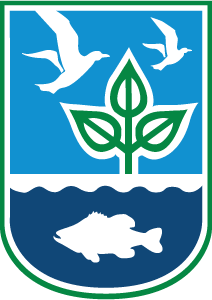Steer Clear of Harmful Algae Blooms this Summer
Published on Friday, May 23, 2025
As we approach the summer months and recreational activities on the State’s abundant lakes, ponds and rivers increase, the Rhode Island Department of Health (RIDOH) and the Rhode Island Department of Environmental Management (DEM) remind the public to be on the lookout for harmful algae blooms (HABs). HABs are caused by blue-green algae, also known as cyanobacteria, which are naturally present in bodies of freshwater. Higher temperatures, slow moving water, and high amounts of nutrients cause the cyanobacteria to grow excessively and create potential for HABs. These HABs can produce toxins which can be harmful to humans and animals.
RIDOH and DEM work together to monitor and respond to HABs and issue recreational advisories when thresholds are met. During a HAB, all recreation, including swimming, fishing, boating, and kayaking should be avoided. In addition, people should not drink untreated water or eat fish from affected waterbodies. Pet owners should not allow pets to drink or swim in this water. State and local officials work to post warnings around bodies of water when HABs are present. However, the public should be on the lookout for HABs and know to avoid affected waters if they encounter a HAB before warnings have been posted.
Affected waters may be bright to dark green in color and have dense, floating algal mats on the water’s surface. The water may look like green paint, thick pea soup, or green cottage cheese. If you see bodies of water that look like this, it’s best for people and pets to avoid contact with the water.
Skin contact with water containing blue-green algae can cause irritation of the skin, nose, eyes, and throat. Symptoms can include stomachache, diarrhea, vomiting, and nausea. Less common symptoms can include dizziness, headache, fever, liver damage, and nervous system damage. Young children and pets are at higher risk for health effects associated with HABs because they are more likely to swallow water when they are in or around bodies of water.
If you come into contact with a HAB, rinse your skin with clean water as soon as possible and, when you get home, take a shower and wash your clothes. If your pet comes into contact with the water, immediately wash your pet with clean water and do not let the pet lick algae off its fur. Call a veterinarian if your pet shows any symptoms of blue-green algae poisoning, including loss of energy, loss of appetite, vomiting, diarrhea, or any unexplained sickness that occurs within a day or so after being in contact with a HAB. People who have had contact with a HAB and have any of the symptoms described above should call a healthcare professional.
To report suspected blue-green algae blooms, contact DEM’s Office of Water Resources at 401-222-4700 or DEM.OWRCyano@dem.ri.gov and if possible, send a photograph of the reported algae bloom. For more information and to see the new Cyanobacteria Tracker Dashboard that lists current advisories and data, visit: www.dem.ri.gov/bluegreen
